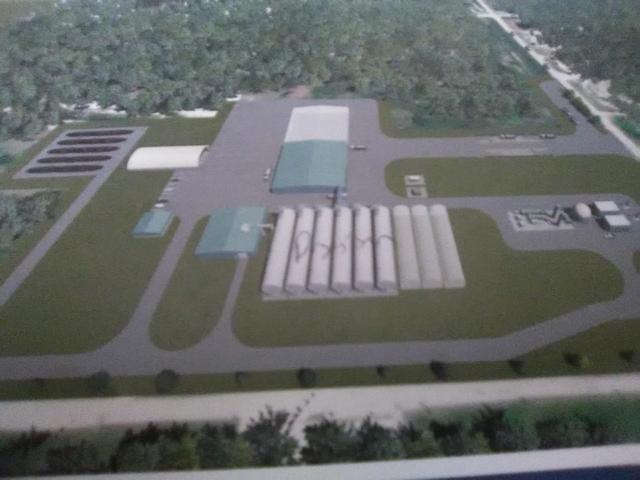
ALTON – A rather ambitious and risky plan was presented to the Alton City Council Wednesday evening by Wastewater Treatment Manager Steve Gibson and representatives from outside firms regarding what is being called the Alton Resource Recovery Facility.
Get The Latest News!
Don't miss our top stories and need-to-know news everyday in your inbox.
Plans for the facility have been in the works for three years, Gibson said, and the initial phase of a feasibility study has been completed as of the early summer of 2017. Phase two of the plan is currently reaching its conclusion. If created, the Alton Resource Recovery Facility would be the first of its kind in the United States, something Gibson said in previous interviews would “put Alton on the map.” But, the cost to put that on the map would be somewhere in the neighborhood of $54 million given Wednesday night's presentation data.
Recently, the city has approved a contract with Illinois American Water to sell its wastewater treatment facility for a sum around $53.8 million. Unfortunately, Alton Mayor Brant Walker said that otherwise astounding windfall will be directly invested into the city's massive pension debt, which had recently be recalculated to be around $113 million. The proposed Alton Resource Recovery Center would have been built on the site of the current aging wastewater treatment facility, but that has become an impossibility with its looming sale to Illinois American Water.
However, Gibson said Illinois American Water has not only agreed to take all the employees from the Alton wastewater treatment facility in the purchase agreement, but would also provide biosolids to the proposed Alton Resource Recovery Center.
So where would that $54 million initial investment go? The proposed Alton Resource Recovery Center would be built on 14-15 acres of land and include a complete facility dedicated to creating renewable energy from a collection of biosolids from wastewater as well as manure and some garbage, and yes, biosolids does mean poop.
Taking away from that daunting $54 million sum, however, is the promise of the facility being able to be a dependable source of economic growth for the city. Under the current model, the facility would generate revenue in a number of ways.
Firstly, through contracts with other municipalities, corporations and businesses, the Alton Resource Recovery Center would be paid to accept waste coming from other places. During phase two of the plan, Gibson worked with feasibility study advisers, Tyler Pjesky of Bartlett and West, Brad Pleima of EcoEngineers and Tom Crabtree, the Director of Public Finance at Stifel, to locate feed stocks for the plant.
This was a bit of an undertaking, as the group's goal was to receive letters of intent signed by interested parties, which designated an interest in future contract work with the city assuming the plant is approved and built. The parties behind these letters of intent and general interest would be the initial investments into the plant – as they would be paying Alton to take their waste.
As of now, the group has an impressive list of interested parties seeking a place to send their waste, including: the St. Louis Metropolitan Sewer District, which has expressed interest with at least three of their facilities, with the possibility of more once the plan is developed, Granite City, which has yet to formally sign a letter of intent, Maschhoff's, which specializes in swine manure, Collinsville, East Alton, Godfrey and the City of Alton.
What happens to the waste shipped by these parties? In the proposed facility, trucks would be weighed at the entrance before the waste was extracted from them and placed into five anaerobic digestors, which are approximately 150 feet long and 30 feet tall. Those anaeobic digestors will process this organic waste and send the gaseous product to small refining facilities located on-site. These would remove the excess impurities from the product and ensure the gas is a quality of methane, which can be placed into the natural gas pipeline to be shipped across the country.
As of now two parties are interested in providing pipeline access to the facility, Ameren and Enable Mississippi. The facility would then collect revenue based on the fuel created. Pjesky said a facility the size of the one being proposed in Alton could create as many as 7,700 gallons of diesel quality fuel per day.
So, the facility would have guaranteed revenue if it attained high-value long-term contracts for waste disposal from several entities. Pjesky said attaining municipalities would be of a higher-value, as those biosolids are more valuable for high-quality fuel, and municipalities are almost guaranteed to perpetually exist and require waste management, unlike companies, which face the possibility of bankruptcy and dissolving. It would also have a constant source of revenue from selling the product to the pipeline.
Neither of those are where the real income will be reaped from this ambitious product, though. The real money-maker for Alton would be its ability to sell Renewable Identification Number (RIN) credits on the RIN marketplace.
Under current federal law, petroleum producers, exporters and refiners are required to offset their production of fossil fuels by a certain amount of renewable energy creation. Since many do not create this energy themselves, or not enough to offset their production of fossil fuels, entities which do generate renewable energy (such as natural gas biofuels) are given RIN credits based on production. Those can be sold on the RIN market, but that market fluctuates like any other speculative commodity market.
If the natural gas piped from the proposed Alton center is proven to be used for transportation fuel, which it most likely will be, it will also be eligible for renewable energy credits from the State of California – an additional source of revenue from the plant.
Given current market numbers, which were on the increase in late 2017, despite the seemingly fossil-fuel-favorable administration of current U.S. President Donald Trump, Alton's resource recovery center would pay for itself in as little as eight years.
According to a presentation from Gibson and the third parties working on phase two of this plan, the plant would have $5,925,910 in annual expenses, but see a gross revenue of $12,712,371, which would create a hypothetical net revenue of $6,786,461, meaning the plant could generate as much as $82,538,208 after a decade of operations. These numbers, however, do not take into account possible financing costs.
Crabtree addressed some of those financing possibilities at Wednesday's meeting as well. He was extremely frank about the situation, saying many potential investors may be skittish about investing, because the project is so cutting edge it seems risky to investors. Many, he said, are not familiar with the RIN credit marketplace, as it was only established as recently as 2014.
Given current figures, without the revenue from RIN credits, the low side of revenue would see the facility paying for itself within 37 years, netting $1,468.339 in revenue each year. At the height of the RIN marketplace the facility could pay for itself in as short as 5.6 years, netting as much as $9,662,177 in annual income. These numbers do not account for financing, though.
Crabtree said the city could work with private entities and investors, but advised the city should be confident in the plant's ability to generate revenue for both Alton and potential partners. Outside of partnerships, Crabtree said the city could issue bonds to pay for the initial construction costs and maintenance.
A general obligation (GO) bond is a municipal bond backed by both the credit and taxing power of the issuing jurisdiction rather than the revenue generated from a given project. The downside of this form of bond is the fact property owners will be held accountable for repaying this debt if the recovery facility does not match expectations.
Under current market conditions, after 20 years, this form of financing would cost the city a projected $88,540,920 in debt servicing, but would potentially net as much as $91,260,398 in revenue for the city. These numbers are all hypothetical and based on current market conditions.
Another option for financing the facility would be issuing revenue bonds. Revenue bonds are municipal bonds issued for income-producing projects secured by that revenue source. Utilizing this sort of bond under current market conditions would take a portion of that revenue and move it toward debt service cost if Alton chose that option. Projected debt servicing would see Alton pay as much as $117,166,506 and net $62,634,812 after two decades of facility operations.
These numbers were not meant to be projected figures, but instead are mere comparisons of possibilities, Crabtree said.
Gibson added the facility as it is currently planned would be able to have room for expansion. He said the construction of additional digestors would not increase the cost by any sort of astronomical amount and would generate significantly more revenue for the city.
The discarded waste could also be used as compost to create even more marketable products, such as nitrates and phosphates for fertilizer. Gibson hinted a large buyer for these sorts of products has also expressed interest in the facility, meaning the revenue figures could even increase from the figures shown above.
Next steps in the process will include the Alton City Council approving the phase to continue working during its second meeting in May 2018. If approved, Gibson said letters of intent from potential feed stocks and pipeline providers could become actual long-term contracts. Crabtree also suggested the entire plan be inspected by an additional party with no vested interest in the project in the interest of feasibility.
If created, the facility may be in operation within the next three years. It would be the first of its kind in the country. As many as 65 landfills currently operate similar processes, and as many as five facilities across the country utilize this process in wastewater treatment facilities, including in Chicago, Portland, Oregon and Madison, Wisconsin. Unlike those, however, Alton's would not only use its own biosolids, but would serve as a hub for nearby areas to dispose of theirs as well. No such facility exists or is in any advanced phases of development in the St. Louis area at this time.
A source close to the project also said this plant, if built, could be a contender for the largest of its kind in the United States, and possibly the world.
More like this:

